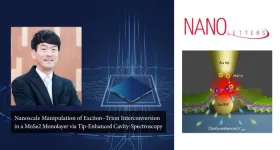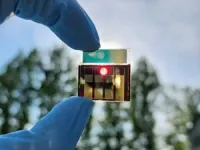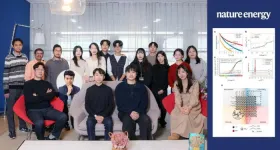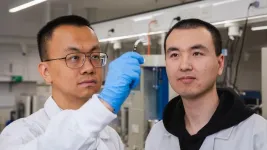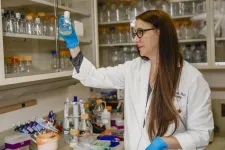(Press-News.org) In a significant advancement for next-generation semiconductors, a collaborative research team, led by Professor Kyoung-Duck Park and Mingu Kang in the Department of Physics at POSTECH, Professor Yong Doug Suh in the Department of Chemistry at UNIST, who concurrently holds the position of Associate Director at the IBS Center for Multidimensional Carbon Materials (CMCM), and Professor Hyun Seok Lee in the Department of Physics at Chungbuk National University, has made groundbreaking discoveries in the field of two-dimensional (2D) semiconductors. Their findings, published in Nano Letters, shed light on the generation and control of trions, providing valuable insights into the optical properties of these materials.
Two-dimensional (2D) semiconductors, known for their exceptional light characteristics per unit volume with high flexibility due to their atomic layer thickness, hold immense potential for applications in areas, such as advanced flexible devices, nano photonics, and solar cells. The research team focused on harnessing the optical properties of 2D semiconductors, particularly the generation and recombination processes of electron-hole pairs, to develop light-emitting devices and optical applications.
To actively control the interaction of excitons and trions and analyze real-time luminous properties, the team developed their own probe-enhanced resonant spectroscopy system based on gold nanowires. By combining a single layer of MoSe2, a two-dimensional semiconductor, with gold nanowires and a probe-enhanced resonance spectroscopy system, the researchers created a composite structure and a powerful analysis platform. Through this, they succeeded in identifying the principle of generating trions, which had not been known before.
The researchers discovered that the multipolar mode of electric charge plays a significant role in inducing the conversion of excitons to trions in two-dimensional semiconductors. With the probe-enhanced resonance spectroscopy system, they achieved real-time analysis of nano-light properties with an exceptional spatial resolution of approximately 10 nm, surpassing the limit of light diffraction. This enabled the identification of the principle behind trion generation and the development of reversible active control over the exciton-trion conversion.
Moreover, the gold probe acted as an antenna, focusing light on a nano-sized area and generating high-energy thermocrons. The electrons generated by this process were then injected into the two-dimensional semiconductor, further enhancing the control over trion generation. This breakthrough led to the proposal of a novel “nano active control platform,” enabling real-time, ultra-high-resolution control over the state of matter, surpassing traditional measuring equipment.
Mingu Kang, the first author of the study, expressed their excitement, stating, “Not only have we successfully controlled excitons and trions, but we have also identified the underlying principles governing their interaction with plasmons and thermotrons.” He further added, “We believe our research will present a significant breakthrough for researchers in fields utilizing excitons and trions, such as solar cells and photoelectric integrated circuits.”
Meanwhile, the study involved Su Jin Kim of the Department of Physics at Chungbuk National University, Huitae Joo, Yeonjeong Koo, and Hyongwoo Lee of the Department of Physics at POSTECH. The study, which was recently published in Nano Letters, was conducted with support from the Korea Research Foundation, the Ministry of Science and ICT, the Korea Electronics and Telecommunications Research Institute, the Samsung Future Technology Promotion Project, the Korea Institute of Science and Technology Commercialization, the Korea Institute of Chemical Technology, UNIST, and IBS.
Journal Reference
Mingu Kang, Su Jin Kim, Huitae Joo, et al., “Nanoscale Manipulation of Exciton–Trion Interconversion in a MoSe2 Monolayer via Tip-Enhanced Cavity-Spectroscopy,” Nano Letters, (2023).
END
Nanoscale manipulation of exciton–trion interconversion in a MoSe2 monolayer via tip-enhanced cavity-spectroscopy
2024-02-21
ELSE PRESS RELEASES FROM THIS DATE:
Hyperbaric oxygen therapy tested for post-covid conditions
2024-02-21
High-dose pressurized oxygen can stress out old immune cells, leaving behind a younger, better functioning immune system. It helped with acute COVID, and now Anders Kjellberg is testing the method for post-covid as well.
Hyperbaric oxygen therapy, giving patients 100 percent oxygen at a pressure corresponding to 10-20 meters below sea level, has been around for almost 100 years. But the method lacks modern evidence from clinical studies, which also means that there is a lack of knowledge about dosage, all patients receive the same dose.
"When I started my research, I wanted to find out how the treatment should be dosed to different patients," says ...
Revolutionary breakthrough in solar energy: World’s most efficient QD solar cells developed
2024-02-21
A groundbreaking research breakthrough in solar energy has propelled the development of the world’s most efficient quantum dot (QD) solar cell, marking a significant leap towards the commercialization of next-generation solar cells. This cutting-edge QD solution and device have demonstrated exceptional performance, retaining their efficiency even after long-term storage. Led by Professor Sung-Yeon Jang from the School of Energy and Chemical Engineering at UNIST, a team of researchers has unveiled ...
New water batteries stay cool under pressure
2024-02-21
A global team of researchers and industry collaborators led by RMIT University has invented recyclable ‘water batteries’ that won’t catch fire or explode.
Lithium-ion energy storage dominates the market due to its technological maturity, but its suitability for large-scale grid energy storage is limited by safety concerns with the volatile materials inside.
Lead researcher Distinguished Professor Tianyi Ma said their batteries were at the cutting edge of an emerging field of aqueous energy storage devices, with breakthroughs that significantly improve the technology’s performance and lifespan.
“What ...
Focus on patient experience can improve diabetes care
2024-02-21
WASHINGTON—Health care providers who treat diabetes need to think beyond the clinical numbers, such as solely focusing on a person’s glucose goals. Taking the patient experience into account can improve the quality of care and facilitate attainment of treatment goals, according to a new position statement published in the Endocrine Society’s Journal of Clinical Endocrinology & Metabolism.
The position statement reflects the consensus of two virtual roundtables the Endocrine Society held in 2022. Participants ...
KIER’s success in the development of the world's top-level semi-transparent perovskite solar cells
2024-02-21
The Photovoltaics Research Department of the Korea Institute of Energy Research (hereafter KIER), working with the KIER Energy AI and Computational Science Lab, has achieved advancements in the stability and efficiency of semi-transparent perovskite solar cells. These cells have potential use in building windows and tandem solar cells*. The semi-transparent solar cells achieved a record-breaking efficiency of 21.68%, making them the most efficient amongst the perovskite solar cells using transparent electrodes in the world. Additionally, they showed ...
NIH grant to aid Rumbaugh’s biofilm dispersal research
2024-02-21
Most chronic wound infections share one thing in common: the presence of biofilms, which are composed of many different microorganisms that congregate as a mass, usually on some type of surface such as a wound bed. Biofilms are thought to be associated with up to 80% of infections, and their ability to stick together makes the biofilm and infection exceptionally difficult to kill.
To combat this health care challenge, researchers such as Kendra Rumbaugh, Ph.D., a professor in the Texas Tech University Health Sciences Center (TTUHSC) School of Medicine’s Department of Surgery, are pursuing biofilm dispersal agents such as ...
Study details toxic elements found in stranded whales, dolphins over 15 years
2024-02-21
Whales and dolphins get their nutrients and essential elements through their diet. While eating fish, squid, octopus, crustaceans and other marine mammals, they are also exposed to heavy metal contaminants.
Elevated levels of toxins have been found in stranded dolphins and whales along the Southeastern Coast of the United States. Monitoring toxic contaminants in these stranded marine animals, which serve as important sentinels of environmental contamination, and whose health may be linked to human health, is vital.
Yet, data remain sparse on how specific elements are distributed within an animal’s body, especially for many rarely encountered ...
Inaccurate pulse oximeter readings could limit transplants, heart pumps for Black patients with heart failure
2024-02-21
Racially biased readings of oxygen levels in the blood using pulse oximeters may further limit opportunities for Black patients with heart failure to receive potentially lifesaving treatments, such as heart pumps and transplants, a Michigan Medicine study finds.
“This is especially important because we know that Black patients are already less likely to receive heart pumps or transplants compared to their white counterparts, and these inaccurate readings can further widen a disparity that must be addressed by our health care system,” said first author Scott W. Ketcham, M.D., a third year ...
An awkward family reunion: Sea monsters are our cousins
2024-02-21
KANSAS CITY, MO—February 21, 2024—The sea lamprey, a 500-million-year-old animal with a sharp-toothed suction cup for a mouth, is the thing of nightmares. A new study from the Stowers Institute for Medical Research discovered that the hindbrain—the part of the brain controlling vital functions like blood pressure and heart rate—of both sea lampreys and humans is built using an extraordinarily similar molecular and genetic toolkit.
Research from the lab of Investigator Robb Krumlauf, Ph.D., published on February 20, 2024 in Nature Communications offers a glimpse into how the brains of ancient animals evolved. The team unexpectedly uncovered that ...
Highways through historically redlined areas likely cause air pollution disparities today
2024-02-21
As part of the New Deal, several governmental programs were created to expand homeownership through mortgages and loans. However, neighborhoods with primarily Black or immigrant communities often were rated “hazardous” for repayment under the discriminatory, “redlining” practice that restricted lending. Today, those same areas are exposed to more air pollution than other urban neighborhoods, and according to research published in ACS’ Environmental Science & Technology, the cause could ...
